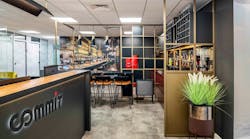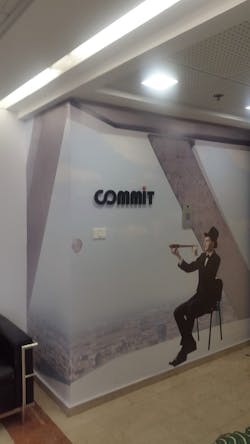Commit, an Israeli-based global technology and custom software solutions company, is expanding into North America with the launch of Commit USA. The new business unit is led by Max Nirenberg, serving as its managing director and chief revenue officer, from its headquarters in New York City (Figure 1).
Nirenberg will lead and optimize Commit’s growing international organization, oversee strategic planning for the global account management teams and ensure the company’s delivery capabilities meet the U.S. market needs.
“The pace of tech innovation has never been more intense, with more startups launching, and failing, than ever before,” says Arik Faingold, president, Commit. “A great idea alone is not enough to succeed. What many organizations lack are the engineering capabilities, development know-how and adequate resources to get their product into market. This is where Commit can help. Max’s experience and passion for building successful sales teams and customer-centric services on a global scale will be invaluable to our organization and customers as we expand into new international markets.”
Founded in 2005, Commit is one of Israel's R&D and software development firms, offering a range of engineering capabilities and resources to design and deliver any project. The firm’s proprietary Flexible R&D methodology is designed to transform its clients’ technology visions into high-quality products. The company specializes in a range of advanced technologies and applications for multiple industries including Internet of Things, medical technology and consumer goods.
Commit has led more than 1,200 projects for more than 1,000 organizations worldwide, with clients ranging from early-stage startups to global brands including IBM and, SanDisk (Figure 2).
Figure 2: Commit has led more than 1,200 projects for more than 1,000 organizations worldwide, with clients ranging from early-stage startups to global brands including IBM and, SanDisk.
“Commit’s expert engineering capabilities and methodology for project management gives us the flexibility to provide hands-on services and shift resources to quickly scale whenever a need arises,” says Nirenberg, who brings more than 20 years of management experience to Commit USA, with a strong specialty in SaaS and tech services. Previously, he served as the global chief sales officer for quality assurance company, Qualitest, where he oversaw teams across three continents and helped to sell the organization in its latest private-equity round for approximately $400 million in 2019. Prior to Qualitest, Nirenberg was an equity partner and VP sales/professional services at Venator Sales Group, a sales management consulting and training firm.
Commit is a global tech services company with offices in New York, Israel and Ukraine. The company was founded in 2005 and has more than 500 multi-disciplinary innovation experts who serve a broad range of companies from small startups to large enterprises in multiple business sectors. Commit specializes in advanced technologies and applications with dedicated practices in software, IoT, big data, cloud and cyber.
What are three key things that a machine builder, system integrator or manufacturer should know about your organization?
Max Nirenberg, managing director and CRO, Commit: We take a product-centric approach, rather than a technology-centric approach. Our goal is to build the best solutions for our customers that not only fully meet, but exceed their product and business needs.
We believe that the original driver of both technology and product is the business and, specifically, the pains a business is trying to solve. After that, product and technology drive each other in turn. Therefore, we use product development to drive our technological innovation, and not the other way around.
Following this approach, we always tailor-make our solutions and choose the most appropriate technology for solving the specific problem at hand, as to avoid restricting our product department’s capabilities and innovation. If no suitable candidate is found, we will develop one.
What new technologies are driving product development and why?
Max Nirenberg, managing director and CRO, Commit: In recent years, we’ve seen a massive rise in the fields of IoT, IIoT, big data, AI and healthcare, and much of this innovation incorporates some elements of IoT, either to enable a device and its end goal or as a main data source for the operation.
The field of IoT is driven by constantly growing demand, but in the past several years, it received a significant boost due to new technologies that enabled better, cheaper, faster and more secure and reliable device-to-device communications, as well as better methods to leverage IoT capabilities.
A few examples would be:
- big data engines. Many innovations and new technologies in big data, such as Hortonworks DataFlow and Data Platform (HDF/HDP), MemQL and Elasticsearch, are enabling organizations to leverage the data from devices to generate entirely new and actionable insights, many of which can be extremely challenging, if not impossible, and expensive to calculate otherwise.
- management and provisioning. Advanced platforms for deploying, onboarding, provisioning, securing and controlling IoT devices and remote version updates are becoming increasingly affordable as a managed service. For example, AWS IOT Core or Azure IOT Hub significantly reduce time to market for leveraging IoT devices in the real world, with both control and scaling capabilities. This enables organizations to grow fast and rapidly develop, focusing on their core business and competency.
How does the Industrial Internet of Things figure into business strategy?
Max Nirenberg, managing director and CRO, Commit: IoT capabilities and their companions, such as big data and automation, enable businesses to transition into data-driven organizations. This evolution can greatly improve the operations of all departments—business, operations, R&D, customer services—by providing new and essential tools such as automated process controls and standardized decision-making to help groups collaborate in a unified direction.
The ability to use data and collaborate better will also increase the volume and speed of operations and will force organizations to become more velocity-centric and a bit less price-centric.
For example, organizations can leverage IIoT capabilities to help with:
- business intelligence and maximizing profits. Before IoT, device manufacturers, sellers and integrators had to rely on assumptions regarding the use of their devices and services and often only received feedback from labs, beta testers, focus groups or angry customers. With the emergence of IoT, collecting business data from real-world use cases has become much faster, cheaper and more accurate, enabling businesses to make smarter decisions based on hard data.
- faster time to market with better quality. With real-world IoT data, organizations have new insight and feedback about the product in a significantly shorter amount of time, which enables development teams to solve issues faster. Superior data will also help the product and business teams to better plan for the future and align strategy with the business goals while reducing time and costs for R&D (Figure 3).
- better control & more accurate forecasts. By leveraging automation and big-data systems, organizations can develop more accurate forecasts, mitigate business and cashflow risks and, overall, react much faster to market changes and adjust their business strategies accordingly.
Figure 3: Superior data will also help the product and business teams to better plan for the future and align strategy with the business goals while reducing time and costs for R&D.
How will machine automation and controls alter the way companies staff their operations in the future?
Max Nirenberg, managing director and CRO, Commit: The rising adoption of AI and automation has been transformative across operations for businesses everywhere. From streamlining workflows and procedures to the way employees are onboarded and trained, organizations will have to adapt to comply with a new way and scale of work.
Organizations are becoming more data-driven and controlled, with the ability to both react faster and work with larger volumes—customers, goods, supply chain—due to connected tools for robotically powered repetitive actions and service automation. These capabilities will increase scale of services, while reducing the need for manual intervention.
As more tasks are moved from humans to machines, staffing for operational teams will become more focused on managing automation, rather than manual labor. The entry level for many of the operational positions will rise, and add to it required technological know-how, while the positions themselves will have more responsibility spanning over a larger amount of controlled process.
Another trend we are likely to see is more extensive offload of operational functions to third-party service providers, mostly in the realms of development, support, monitoring and DevOps (software development and IT operations). This offloading will enable businesses to cost-efficiently meet the rapidly rising need for more multidisciplinary trained personnel.
Though the operational cost per single employee may increase, this change will overall yield a better ROI on operations teams due to improved efficiency and the ability to perform more complex tasks and larger volumes of operations in a lower amount of time.
How is the development of software solutions impacting requirements for hardware?
Max Nirenberg, managing director and CRO, Commit: Aside from special cases, like video cards and their drivers, the current trend is to create as much decoupling as possible between software and hardware components. This is due to the very different lifecycles of both and the different challenges they both face.
Due to more complex and costly development and testing cycles, hardware solutions are less flexible by nature than their software companions in terms of the possible speed of introducing new features and capabilities to the market.
For example, as the Internet became faster, more data could be collected and the number of users grew, the hardware world could not keep up. The demand for increased power, memory, CPU and other server parameters needed to keep working cost efficiently became overwhelming, so, as a solution, the software world began moving from monolith services to distributed systems.
This allowed the software components to scale out horizontally. Instead of needing to invent a more powerful CPU or motherboards that can support more RAM, teams can now take several of the traditional, inexpensive servers and bind them together using the software. Whenever the need for additional compute power arises, organizations can just add more of the same hardware to answer the demand.
The decoupling trend is also moving the industry to create more generic hardware components that can be utilized by software to answer different needs. One aspect of this transition is that more and more logic and heavy lifting has moved from the embedded software layer, which is device-specific and dependent on the hardware parameters, into other application layers such as external servers and cloud solutions.
Decoupling enables the reduction of IoT device hardware requirements in terms of compute demand, power consumption and manufacturing costs. It also allows IoT capabilities to yield better value to end users, as the logic—the brain—of its operation is far less constricted by the single hardware unit that it operates.
As engineering and IT continue their convergence, which one is and/or will be leading the direction of future automation and technology?
Max Nirenberg, managing director and CRO, Commit: I don’t believe there will be a specific lead in terms of progress and innovation as engineering and IT are two parts of the same solution, and both are required to close an end-to-end loop for any requirement.
Having said that, in terms of process of development and rollout of products, services and systems, the lead is assumed by engineering, as IT is there to answer the engineering requirements. The initial driver of all requirements, however, is the business need. This requirement will first come to the engineering departments to build, integrate and/or evaluate a solution.
From this point, the engineering department takes ownership of the process, and they will create a solution that meets the business requirement. Additionally, they will create the IT requirements that will have to be implemented by the IT department.
As engineers have more direct contact with the business and customers, in most cases, I assume that they will be the main driver and lead for creation of future automation technology. However, IT will have to keep up with the demand, as well, so engineering and IT will have to work hand-in-hand in order for any one of them to succeed.









